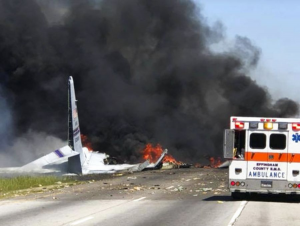Plane Crash
By Michael FaginWeather for PilotsWith 0 commentsPlane crash and the ensuing forensic analysis is critical as we look at a recent cargo plane crash. Beyond the tragedies that spawn from victims losing lives, small aviation accidents may lead to insurance claims of hundreds of thousands of dollars, while large accidents can devastate into the billions. In 2015, there were 1,282 civil aviation accidents and 238 were fatal, including 406 fatalities. That’s actually down from 2014’s 1,290, with 444 deaths in 265 fatal accidents. Even that statistic was an improvement from 2013’s 1,298, with 429 deaths from 236 fatal accidents. The credit for the declining numbers for both civil aviation and government accidents is popularly attributed to better safety precautions and weather predictions. The decline, however, likely can’t continue to be so steep, if it doesn’t someday reverse.

Plane Crash. Cargo plane
Air National Guard Aircraft Crashes in Georgia, Wipes out Electrical Grid
At the beginning of May 2018, a Air National Guard cargo plane of the 156th Air Wing from the Puerto Rican Air National Guard crashed in Georgia at an intersection near Savannah/Hilton Head International airport. The 40-year-old aircraft flew into Savannah for routine maintenance. It then headed to Tucson, AZ, ironically, to be decommissioned.
Something still uncertain happened in the sky. With a wing span of 132’, the C-130 Hercules soared downward and ripped through several electrical service lines. It left only a 600’ diameter field of debris but disabled a significant section of the city, imposing a huge economic impact. The crash and explosion left all nine aboard dead. Despite reported traffic going both ways, miraculously, no one on the busy roads was hurt.
A Weather Consultant’s Forensic Analysis of a Cargo Plane Crash
Weather consultants look at many meteorological tools to put forth a best effort at determining details of either future or past events. Some of them include: world airspace system data, 500 mb atmospheric layer maps, upper-level air soundings, surface maps, ice forecasts, turbulence data and conditions around the time of the crash.
In the case of the plane crash in Savannah, it’s still unclear if weather, such as turbulence, may have been a factor. Although it clearly wasn’t stormy, as seen in the photo, a called upon weather consultant would seek out the clues provided by observations and models from the time of the event where the plane was flying, as well as the surrounding atmospheric layers. A professional opinion from an experienced weather consultant holds weight in court when weather is suspected of having caused bodily or property damages.
Written by Meteorologist Geoff Linsley
